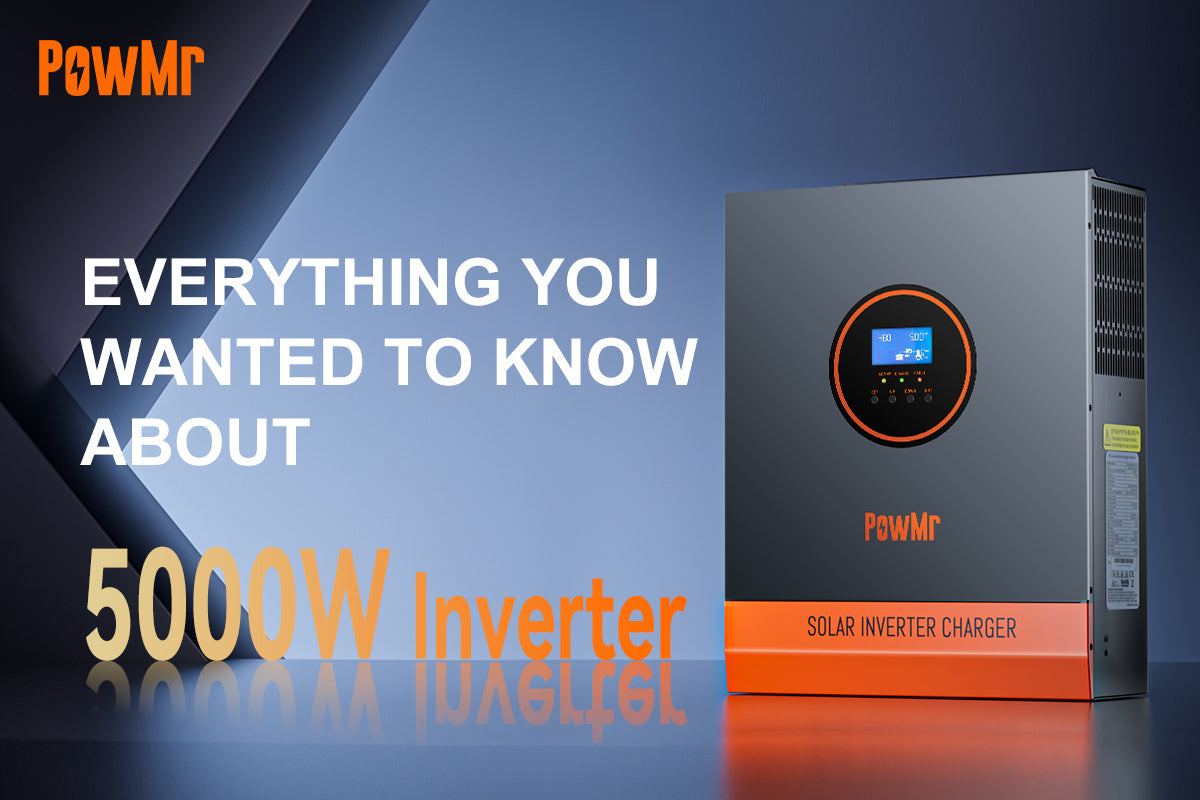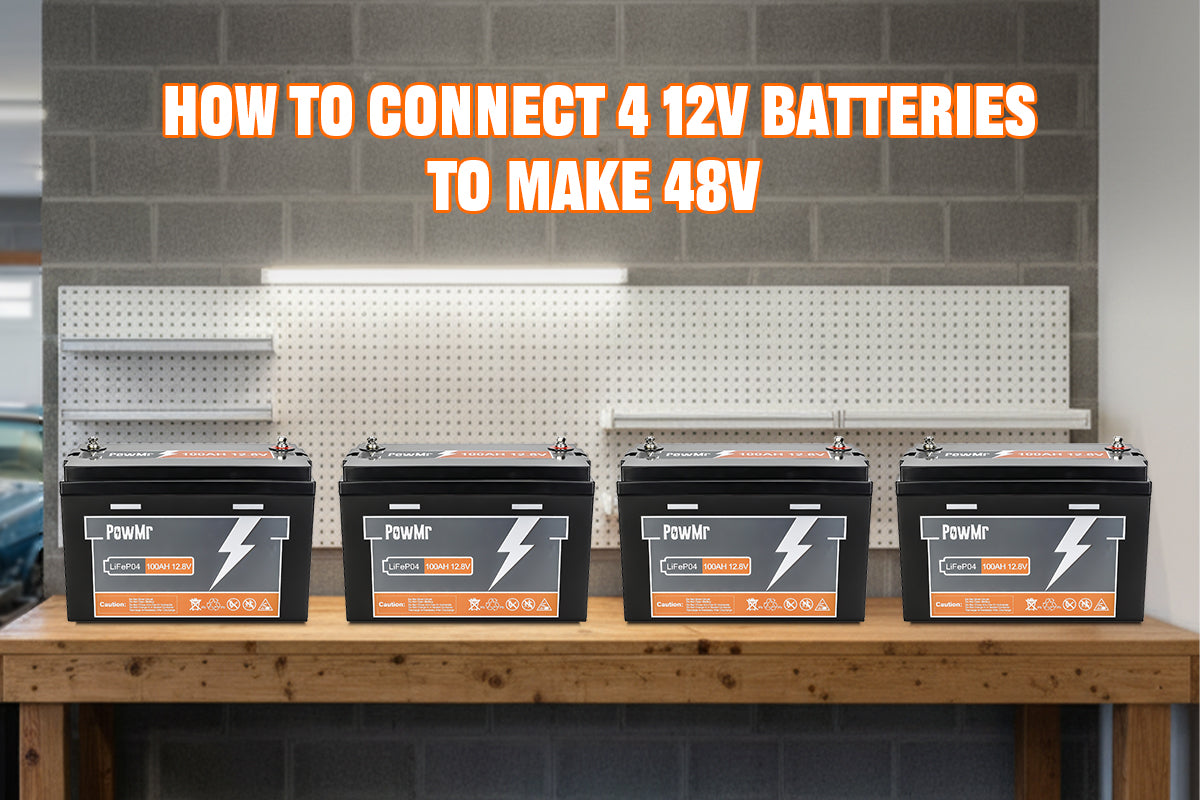5000W is a commonly used inverter rated power, offering enough capacity for running everything from essential home appliances like refrigerators and microwaves to demanding power tools, making it a popular choice for middle size systems in off-grid cabins, home backup systems, and large RVs.
Deciding on your battery bank is the most critical step when designing a system around a 5000W inverter. To directly answer the main question, you will typically need between 4 and 12 batteries for a 5000W inverter. However the exact number depends entirely on your system's voltage, the battery type (lithium vs. lead-acid), and how long you need to run your appliances.
This guide will walk you through the calculations to build a reliable battery bank, explain what a 5000W inverter will run, and determine number of solar panels you can connect to.
How Many Batteries Do You Need for a 5000w Inverter?
To determine the number of batteries needed for a 5000-watt inverter, several factors come into play. In addition to the obvious ones such as battery voltage (12V, 24V or 48V) and amp-hour (Ah) rating, it also depends on how long you intend to run the inverter at that specific load.
Here is a formula for simply calculating the number of batteries for inverters:
Number of Batteries = (Inverter Rated Wattage × Runtime Hours) ÷ (Inverter Efficiency × Battery Voltage × Battery Capacity × Depth of Discharge)
Variable Breakdown:
- Inverter Rated Wattage (W): For this guide, running the inverter at full load (5000W) for guarantee max power is always available in high demand situation.
- Runtime (Hours): How many hours you need to run the 5000w inverter (e.g., 1, 2, or 4 hours).
- Inverter Efficiency: The energy lost as heat by the inverter. Use 0.90 for high-quality pure sine wave inverters.
- Battery Voltage (V): The nominal voltage of a single battery you plan to purchase.
- Battery Capacity (Ah): The Amp-hour rating of a single battery.
- Depth of Discharge (DoD): The percentage of the battery's energy you can safely use. Use 0.80 for a high-quality battery as specified in the example, or adjust based on your battery's specifications.
Example: How many 12V batteries for 5000w inverter
By plugging the values into the formula (5000W × 2h) ÷ (0.9 × Battery Voltage × 100Ah × 0.8), and assuming an inverter efficiency of 90% and a battery Depth of Discharge of 80%, we get about 11.6, which means twelve 12V 100Ah batteries are needed to power a 5000W inverter at full load. However, switching to 48V 100Ah batteries reduces the requirement to just 3 units, making the system much simpler and more efficient.
The table below shows how many batteries are needed to cover the 2-hour energy consumption of a 5000W inverter:
| Battery Voltage | Battery Capacity (Ah) | Number of Batteries Required |
|---|---|---|
| 12V | 100Ah | 12 batteries |
| 24V | 100Ah | 6 batteries |
| 48V | 100Ah | 3 batteries |
Beyond considering the energy capacity, another critical point is to calculate the amperage the 5000W inverter will draw from the battery bank. It is essential for selecting the correct battery-to-inverter cable size to prevent overheating, and the demand must stay within the battery bank's maximum discharge current, often referred to as its C-rate.
For more information on cable sizing, see: Inverter Wire Size Guide.
How much amperage does a 5000w inverter pull
This is a critical safety calculation that determines your fuse/breaker size and AWG wire thickness. Drawing too much current through undersized wires is a major fire hazard.
According to the relationship of Amperage (A) = Wattage (W) ÷ Voltage (V), calculate the current.
Also, you can account for inverter efficiency loss: Actual Amperage = Wattage ÷ (Voltage × Efficiency)
Let's see the dramatic current difference attributed to battery voltage:
| System Voltage | Current Draw (Theoretical) | Current Draw (with 90% Efficiency) |
|---|---|---|
| 12V | 417A | 463A |
| 24V | 208A | 231A |
| 48V | 104A | 116A |
This table clearly shows that a 5000w inverter draws about 116amps in a 48v system, which significantly reduces the dangerously high and impractical current levels seen in a 12v system that draws over 460amps. The lower amperage means less heat, smaller cables, and greater overall safety and efficiency. This is why a 48V system is the professional standard for a 5000W inverter.
5000w inverter battery connection considerations
If the inverter's current draw exceeds the battery's maximum discharge rating, it could damage the battery. Therefore, when the inverter pulls more amps than a single string of batteries can safely provide, you must add more identical strings in parallel to divide the current load between them.
This is vital because battery types have vastly different C-rates:
- Lead-Acid (Low C-rate): A 100Ah battery might only handle 20A (a 0.2C rate).
- LiFePO4 (High C-rate): A 100Ah battery can often deliver 100A (a 1C rate).
To handle the 116A draw of our 48V system, you would need 6 parallel strings of lead-acid batteries (116A ÷ 20A/string = 5.8), but only two parallel strings of LiFePO4 batteries (116A ÷ 100A/string = 1.16).
Note:
It should be clarified that the number of batteries mentioned here differs from the conclusion in the section titled "How many batteries for 5000w inverter?" yet both are equally critical: the former pertains to energy capacity (operating duration), while the latter relates to power output (safe current delivery).
You must always build your system to meet the higher of these two numbers, as this is the only way to simultaneously satisfy both the required operating duration and safe power delivery demands.
What can a 5000w inverter run
A 5000w inverter can run a variety of appliances, including many common household appliances like lights, TVs, computers, and smaller kitchen appliances.
The 5kW rated power indicates that the inverter can operate at full load continuously without error or damage. This capacity allows a 5kW inverter to run multiple devices in common scenarios, as shown in the table below:
| Appliance Category | Typical Power Consumption | Examples |
|---|---|---|
| Lighting | 50-200W | LED lights, fluorescent lights |
| Electronics | 100-500W | TV, laptop, desktop computer |
| Kitchen Appliances | 800-1500W | Microwave, coffee maker, toaster |
| Power Tools | 500-2000W | Drill, saw, grinder |
| HVAC | 1000-3000W | Small AC unit, space heater |
Important considerations of using a 5kw inverter
Besides, here are some points you should pay attention to when using a 5000w inverter for safety and efficiency:
Pure sine wave output:
Choose a pure sine wave inverter to ensure stable power delivery and protect sensitive electronics. Modified sine wave inverters can cause noise, inefficiency, or even damage to certain appliances.
AC Output Voltage:
When selecting an inverter, pay attention to its AC output voltage and compatibility with your region or equipment. For example, the PowMr SP5K 5kw inverter supports split-phase 110V/240V output in parallel mode, making it ideal for North American systems and appliances that require both 120V and 240V power.
Continuous Power Rating:
A 5000w inverter can continuously power devices that require up to 5000 watts of electricity. Ensure that the total power of all loads you want to run simultaneously does not exceed 5000 watts to avoid overloading the inverter.
Peak Power & Surge Capacity:
Peak power refers to the maximum electrical power required by an appliance or device when starting up. For inductive loads, the peak power is typically 3 to 9 times their rated power because they require extra power to overcome the inertia during startup.
To meet the startup requirements of these inductive loads, it is essential to focus on and compare the peak power of the load and the surge power capacity of the inverter when selecting one.
For instance, the PowMr POW-LVM5K-48V-N inverter triggers an error and shuts down after 5 seconds if the load exceeds 125% ±10% of its rated capacity. And low-frequency series inverters can tolerate up to 3× their rated power.
If the overload is minor, the inverter will automatically shut down and can be reset afterward. However, a severe overload can cause permanent damage.
For more information about overloading, see: What happens if you overload an inverter.
Note:
To maximize your inverter's capability, practice load management. Stagger the startup of large appliances. For instance, wait for the air conditioner's compressor to finish its startup cycle before turning on the microwave. This prevents multiple large surge demands from hitting the inverter at the exact same moment.
How many solar panels can a 5000w inverter handle
The number of solar panels of a 5000w inverter depends on the specified model. You can simply calculate by dividing the inverter's max pv input power by the rated power of the solar panel you use.
Number of Panels = Inverter's Max PV Input Power ÷ Solar Panel Wattage
For example, the 5000w inverter that has a max pv input power of 5500w can handle ten 550w solar panels.

However, for both safety and efficiency, you should always check the inverter manufacturer's specifications and compare them with your solar panel data sheet. Key parameters include:
-
Max PV Input Voltage (Voc): This is the most important safety limit. It refers to the total Open Circuit Voltage (Voc) of your series-wired solar panels. Exceeding this limit will cause permanent high-voltage damage to the inverter.
(Panel's Voc) × (Number of Panels in Series) < Inverter's Max PV Input Voltage -
Max PV Input Current (Isc): This is the maximum amperage the inverter can handle from your parallel-connected solar strings. Exceeding this value can trip internal protections, cause overheating, or damage the controller.
(Panel's Isc) × (Number of Parallel Strings) ≤ Inverter's Max PV Input Current - Charge Controller Working Voltage Range: The total voltage of the panels connected in series must be higher than the controller's minimum operating voltage to start working properly, yet remain below the maximum voltage limit to ensure safety.
FAQs of 5000w inverter
Will a 12v battery run a 5000w inverter
As shown in the earlier calculation, running a 5000W inverter on a 12v battery system would draw extremely high current, quickly depleting the battery and potentially causing damage. For larger inverters like 5000 W units, a 48v battery bank is far more efficient and easier to manage.
How to make 5000w inverter convert 12v to 220v
Since most 5kW inverters use a 48V battery system, you can connect four 12V batteries in series.
To convert the 12v to 220v, you need to confirm the inverter supports this ac power output. For instance:
- PowMr POW-LVM5K-48V-N outputs 110V only, not 220V.
- PowMr POW-SunSmart SP5K parallel mode supports split-phase 120/240V: set Item 31 to enable split-phase, Item 38 for phase voltage 110V, producing 220 V line-to-line. For 220 V single-phase output, you will need a different model.



